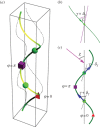A steering mechanism for phototaxis in Chlamydomonas
- PMID: 25589576
- PMCID: PMC4345482
- DOI: 10.1098/rsif.2014.1164
A steering mechanism for phototaxis in Chlamydomonas
Abstract
Chlamydomonas shows both positive and negative phototaxis. It has a single eyespot near its equator, and as the cell rotates during the forward motion, the light signal received by the eyespot varies. We use a simple mechanical model of Chlamydomonas that couples the flagellar beat pattern to the light intensity at the eyespot to demonstrate a mechanism for phototactic steering that is consistent with observations. The direction of phototaxis is controlled by a parameter in our model, and the steering mechanism is robust to noise. Our model shows switching between directed phototaxis when the light is on and run-and-tumble behaviour in the dark.
Keywords: cell locomotion; flagella; phototaxis.
© 2015 The Author(s) Published by the Royal Society. All rights reserved.
Figures

 -axis so when it swims perpendicular to the light direction (orange arrows), the light signal varies. For half the cycle, the eyespot is in the dark, then when the eyespot crosses the horizon line the light signal varies as
-axis so when it swims perpendicular to the light direction (orange arrows), the light signal varies. For half the cycle, the eyespot is in the dark, then when the eyespot crosses the horizon line the light signal varies as  , where
, where  is the angle between the outward normal from the eyespot and the direction towards light. (Online version in colour.)
is the angle between the outward normal from the eyespot and the direction towards light. (Online version in colour.)

 -direction and steers towards the light coming in from the
-direction and steers towards the light coming in from the  -direction. At
-direction. At  the cells with p = 1.2 and p = 1.8 have oriented towards the light, but the cells with p = 0.5 and p = 0.8 are still slowly bending towards the light. (Online version in colour.)
the cells with p = 1.2 and p = 1.8 have oriented towards the light, but the cells with p = 0.5 and p = 0.8 are still slowly bending towards the light. (Online version in colour.)
References
Publication types
MeSH terms
LinkOut - more resources
Full Text Sources
Other Literature Sources

